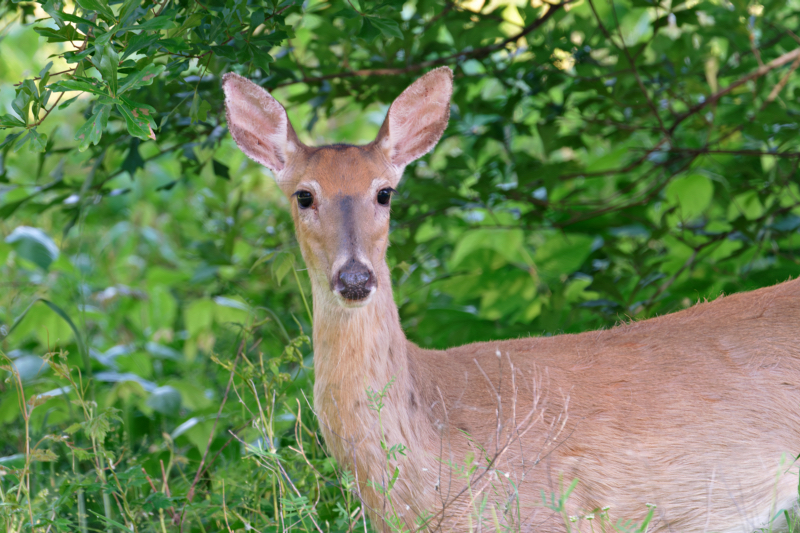I photographed this White-tailed Doe at the Sequoyah National Wildlife Refuge in Oklahoma. It was a sunny morning, around 8:18 AM, with just enough light to bring out the details without being harsh. The doe was standing near the auto tour road, close to a line of trees that runs along the edge of Goss Field. The quiet scene and soft lighting created the perfect opportunity for this shot.

As I approached slowly in my vehicle, I noticed the doe was aware of my presence. She stood broadside to me, her ears perked up and pointed in my direction, indicating curiosity rather than fear. Her calm demeanor allowed me to park nearby without causing her to flee, and she gazed at me long enough for me to get the shot.
Camera Settings and Technique
To capture this moment, I used my Fuji X-T3 camera paired with a Canon 100-400mm lens, set to its maximum focal length of 400mm. Here were the specific settings:
- Date: 5/15/19
- Time: 8:17:54 AM
- ISO: 800
- Aperture: f/7.1
- Shutter Speed: 1/140 sec
- Exposure Compensation: 0.0
- Program: Aperture Priority
The 400mm focal length allowed me to maintain a good distance without disturbing the doe while still filling the frame. Shooting at ISO 800 provided enough sensitivity to capture the image without introducing too much noise. I chose an aperture of f/7.1 to achieve a balance between sharpness on the doe and a soft background blur that made her stand out against the trees.
The Sequoyah National Wildlife Refuge
Located in eastern Oklahoma, Sequoyah National Wildlife Refuge spans thousands of acres and is known for its diverse habitats, including wetlands, grasslands, and wooded areas. Goss Field, where this doe was photographed, is one of the many open fields scattered throughout the refuge, often frequented by deer. The auto tour road offers visitors a chance to experience wildlife up close from the safety of their vehicles.
Photographing Deer: Tips for a Successful Shot
For wildlife photographers, deer can be both rewarding and challenging subjects. Here are some tips for photographing them:
- Use a Telephoto Lens: A lens with at least 300mm reach is ideal. It allows you to capture details without getting too close and potentially scaring the animal.
- Approach Slowly: In places like the Sequoyah refuge, wildlife is more accustomed to vehicles than people on foot. Use your car as a blind and approach slowly.
- Shoot During the Golden Hours: Early morning or late afternoon light provides soft illumination, enhancing textures and colors.
- Watch for Ear Positioning: A deer’s ears can tell you a lot about its awareness and alertness. When pointed at you, it indicates the animal is tuned in to your presence.
This peaceful moment with the White-tailed Doe serves as a reminder of the quiet beauty found in natural settings like Sequoyah National Wildlife Refuge. Each photograph tells a story, and this one captures a brief connection between a photographer and the wildlife, framed in the soft morning light.
